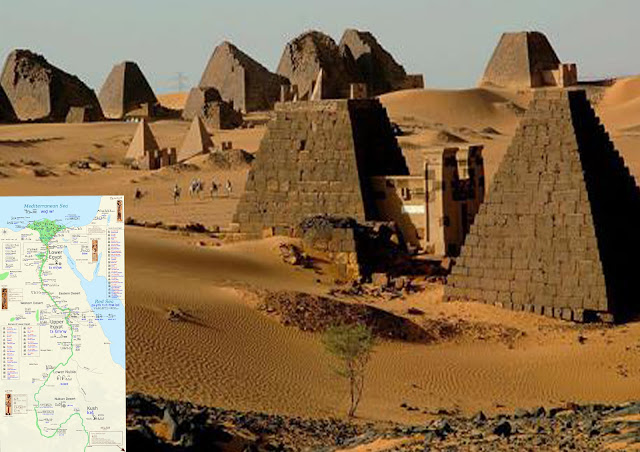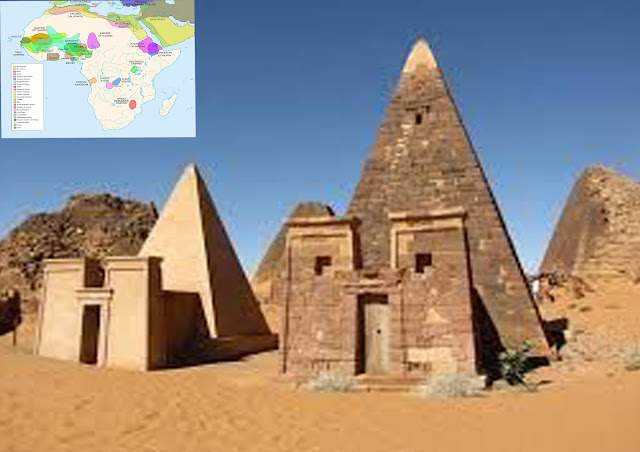The Kingdom of Kush in Africa
 |
| The Kingdom of Kush in Africa |
 |
| Capital in Kush |
Capital
(The Great City of Meroe)
The 25th Dynasty ended with Tantamani, and he was replaced by the Assyrians with a puppet king referred to as Necho I. Necho’s son, Psammeticus I (also referred to as Psamtik I, c. 665-610 BCE), threw off Assyrian rule and founded the 26th Dynasty of Egypt. Psammeticus I and his successor, Necho 2, ruled well, but Necho 2’s successor, Psammeticus II, felt he needed an excellent campaign keep with the good pharaohs of the New Kingdom. He, therefore, led an expedition against Kush, destroying towns, temples, monuments, stele, and finally the city of Napata before he grew bored with the campaign and returned to Egypt.
At this time, c. 590 BCE, the capital of the dominion of Kush moved further south to the town of Meroe for safety. The kings of Meroe continued to emulate Egyptian custom and fashion and follow Egyptian policy and non secular practice until the reign of the king Arkamani I (also referred to as Ergamenes, 295-275 BCE). The Priests of Amun had long held power over the Kushite monarchy by allotting each king a particular amount of your time to reign, and when their god indicated to them that point was up, the king had to die and another was chosen by the priests.
by B N Chagny (CC BY-SA)
According to the historian Diodorus Siculus (Frist century BCE), Arkamani I had been graduated in Greek philosophy & refused to be controlled by the superstitions of the priests. He led a band of men to the temple, had all the priests slaughtered, and ended their power over the monarchy. He then instituted new policies and practices including abandoning Egyptian culture, with a stress on Kushite. Arkamani I discarded hieroglyphic script in favor of another referred to as Meroitic which, to date, has not been deciphered. The fashion of the people of Meroe during his reign shifts faraway from Egyptian to distinctly Meroitic and therefore the gods of the Egyptians become assimilated into Kushite deities like Apedemak. The tradition of burying royalty at Napata was also abandoned and kings would thenceforth be entombed at Meroe.
Another interesting innovation of Arkamani I’s reign was the induction of female monarchs at Meroe. These queens, known as Candaces (also Kandake, Kentake) ruled between c. 284 BCE - c. 314 CE. Although they had male escorts in public ceremonies, they were not subject to male domination. The earliest recorded queen is Shanakdakhete (c. 170 BCE) who is shown fully armor leading her troops in battle. The title of Candace is thought to mean “Queen Mother” but exactly what this refers to is unclear. It may have meant “royal woman” or “mother of the king” initially but the queens who held the title appear as monarchs who weren't defined by their relationship with men. One of these queens, Amanirenas (c. 40-10 BCE), led her people successfully through the Meroitic War between Kush and Rome (27-22 BCE) and was able to negotiate favorable terms in the peace treaty from Augustus Caesar.
Iron and Gold
Two of the foremost important resources of Ancient Kush were gold and iron. Gold helped Kush to become wealthy because it'd be traded to the Egyptians and other nearby nations. Iron was the foremost important metal of the age. it had been wont to make the strongest tools and weapons.
Culture of Kush
Outside of the Pharaoh and thus the upper crust , the priests were the foremost important class in Kush. They made the laws and communicated with the gods. slightly below the priests were the artisans and scribes. Artisans worked the iron and gold that was such an important a neighborhood of the Kushite economy. Farmers were also respected as they provided the food for the all countrys. At rock bottom were servants, laborers, and slaves. just like the Egyptians, religion played a crucial role within the lives of the Kushites. They believed strongly within the afterlife. Women played an important role and can be leaders in Kush. Many of the Kushite leaders were queens.








No comments:
Post a Comment